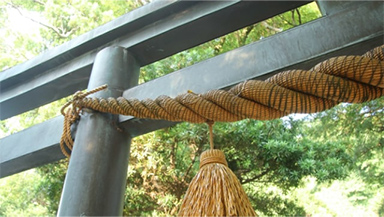Veneration of Nature
The veneration of nature is an important part of the Shinto tradition. Sacred mountains, such as Mt Fuji, and other natural features, such as islands and waterfalls, are regarded as kami in themselves, and as the dwelling places of kami. Almost all jinja have a sacred forest, called a “Chinju no Mori”. At urban jinja this may be very small, even a single tree, while at old jinja it may be an ancient woodland that has been largely undisturbed for centuries. The preservation of this forest is very important, and when a jinja must be moved, the creation of a new sacred forest is an important task. As these forests are sacred, you should only enter and explore them on clearly marked paths, if there are any.

Within this forest, individual trees may be singled out as particularly sacred, and called “shinboku”, which means “kami tree”. These trees often have a sacred shimenawa rope tied around their trunks, and at jinja with many visitors there may also be an offering box before them. Even when there is not, people can often be seen paying reverence to these trees.
This is the current form of an ancient Shinto practice. Before permanent structures were built at jinja, the kami were believed to reside in trees or great rocks, either permanently, or just for the duration of a matsuri. At some jinja, even today natural rocks are regarded as sacred, and marked with a shimenawa rope.
The kami are also seen as present in more fleeting natural phenomena, such as storms or wind. In these cases, the kami reside within the phenomenon, and people call on them to mitigate the fury of nature, and limit the damage to the people of the area.

Shinto sees people as part of nature, and many practitioners believe it is important to preserve the local environment, including the activities of the people living there. Thus, rice fields are as valuable as untouched mountain forests, and most sacred forests are managed by the priests and adherents of the jinja. Shinto is not normally concerned with whether or not people are involved in an ecosystem, but rather with whether it is flourishing. The kami are found in the bounteous energy of life.
Glossary

A twisted straw rope that serves to delineate sacred space and objects. Shide, white paper streamers in a folded zigzag pattern, are often attached to shimenawa.